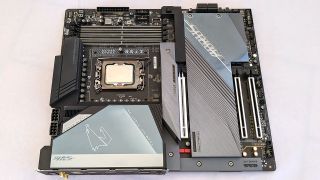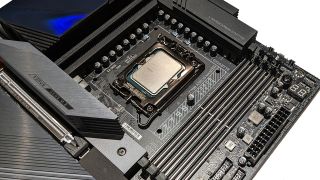Gigabyte’s Aorus Grasp motherboards have historically impressed me. They’re very a lot high-end choices, however aren’t priced wherever close to the highest tier Extremes and Godlikes of the Asus and MSIs of the motherboard world. You continue to get a variety of options on your cash, however while you bounce over $500, diminishing returns actually units in.
Loads was written concerning the bounce in motherboard pricing this technology, although as a second technology LGA 1700 platform, Z790 wasn’t as badly affected because the all new AMD X670/E boards had been again once they launched. The Gigabyte Z790 Aorus Grasp at $499 / £524 / AU$1,029 is way from what you’d name an inexpensive board, however in comparison with a number of the boards costing nicely over that value it is a formidable competitor.
The Z790 Aorus Grasp seems to be an evolution of the Z690 Grasp with a couple of aesthetic tweaks, redesigned heatsinks, and assist for as much as DDR5-8000 reminiscence. The Z690 Grasp grew to become a superb board after it acquired some welcome BIOS updates, and it means the Z790 model could battle to justify its increased value over the now discounted Z690 model.
The Z790 Aorus Grasp is an prolonged ATX motherboard, so some consideration must be taken to make certain it matches in your case. It’s much less of an element than it as soon as was, thanks in no small half to the gigantism of recent graphics playing cards just like the RTX 4090 (opens in new tab). Gigabyte has gone for black and grey theme with only a contact of RGB atop the I/O defend. The look is one which blends kind and performance properly.
Z790 Aorus Grasp specs
Socket: Intel LGA1700CPU compatibility: Intel twelfth & thirteenth Gen desktop processorsForm issue: E-ATXMemory assist: DDR5-8000 (OC), As much as 128GBStorage: 5x M.2, 4x SATAUSB: As much as 3x USB 3.2 Gen2x2, 7x USB 3.2 Gen 2, 9x USB 3.1 Gen 1, 4x USB 2.0Display: 2x DP 1.2Networking: Marvell AQtion 10G LAN, Killer Wi-Fi 6EAudio: Realtek ALC1220-VBPrice: $499 (opens in new tab)/ £524 (opens in new tab) / AU$1,029 (opens in new tab)
A tour across the board reveals some attention-grabbing issues. The PCIe slot structure is clearly constructed with triple and quad slot GPUs in thoughts. The first slot shares its PCIe 5.0 lanes with the first M.2 slot.
The Aorus Grasp is one in all a rising variety of boards which have a PCIe launch change or latch. Because the common PCIe latch might be troublesome to entry with GPUs which have a backplate, this characteristic is a godsend, even when just for the few that change GPUs rather a lot (like us reviewers!).
The Z790 Aorus Grasp is yet one more Gigabyte providing with a nicely engineered cooling meeting. Whereas different producers have tended in the direction of blocky steel warmth sinks that lack floor space, Gigabyte continues to make use of old style conventional finned heatsinks. Our easy check with a vast energy 13900K resulted in a peak VRM temperature of simply 57 levels. Excellent!
The opposite heatsink worthy of focus is the large main M.2 heatsink. With PCIe 5.0 drives anticipated to generate a variety of warmth, this sort of cooling capability may be very welcome. However do not take it as a right. Heatsinks can and do soak up warmth from adjoining graphics playing cards so you may nonetheless want to make sure you have good case airflow.
The board will settle for as much as 5 M.2 drives. Aside from the first slot, they assist as much as PCIe 4.0. There are simply 4 SATA ports. They’re turning into much less and fewer necessary however nonetheless, six can be good at this degree, if not eight.
Different attention-grabbing options embrace a so-called Multi-key button which might be programmed by the consumer to toggle the RGB on or off, boot to BIOS or enter a BIOS protected mode with out dropping your settings.
Regardless of not being awash with blazing RGB, the Z790 Aorus Grasp contains two ARGB headers and two RGB headers. Plus, there are at least ten fan and pump headers, a USB 3.2 Gen 2×2 entrance panel header and energy and reset buttons. Not unhealthy in any respect.
The VRM of the board is an actual spotlight, as you’d anticipate from a board that’s anticipated to energy overclocked 13900K’s. A 20+1+2 part VRM with 105A levels will fortunately present juice for ln2 overclockers. Other than the out and out overclocking boards just like the Aorus Tachyon or Asus Apex, it will be arduous to search out one thing that beats the VRM of the Z790 Aorus Grasp.
If you would like a number of USB ports, the Grasp might be the board for you. There are 14 on the again panel alone. These embrace two 3.2 Gen 2×2 Sort-C and a Gen 1 Sort-C. Becoming a member of these are seven Gen 2 and 4 Gen 1 ports. That is a robust complement, however observe that you don’t get Thunderbolt 4 or USB 4. They actually would have been welcome however in equity to Gigabyte, they’re one of many few options that makers use to justify the price of the halo tier motherboards. USB 4 will ultimately be as ubiquitous as USB 3.0 is at present. After all it could be known as USB 4.7 Gen 4×4 or another ridiculous identify, however I digress.
The Grasp contains 10G Lan and Killer Wi-Fi 6E. We like to see 10G and hope it trickles right down to cheaper boards sooner or later. The board contains ALC1220-VB audio which appears like final gen, although it’s a robust implementation with Gigabyte’s dependable selection of parts, together with an ESS ES9118 DAC.
System Efficiency
Gaming Efficiency
As I say in most motherboard evaluations, utilizing benchmarks to guage a motherboard is not all that related except there’s some actual underlying subject that stands out. A p.c or two right here or there or margin of error variations do not imply a lot in the true world.
The Z790 platform is mature, and with energy and turbo settings as shut as its doable to set between boards, the outcomes are typically shut. Nonetheless , the Aorus Grasp carried out nicely, notably beneath multithreaded hundreds. Add to {that a} very cool and robust VRM and also you get the sensation it is a board that will not have an issue being thrashed with heavy hundreds. It is no slouch at gaming both.
Check rig
CPU: Intel Core i9 13900KGraphics: Zotac GeForce RTX 3080 Ti AMP HoloRAM: 2x 16GB G.Talent Trident Z5 DDR5-6000 C36Storage: 2TB Seagate FireCuda 530Cooling: Cooler Grasp PL360 Flux 360mm AIOPSU: Corsair AX1000
The BIOS of the Z790 Aorus Grasp is just miles forward of my first impressions previous to the twelfth Gen launch when DDR5-6000 struggled to run. I reviewed a set of G.Talent DDR5-7200 (opens in new tab) on the Z790 Aorus Grasp and it ran flawlessly. Actually I used to be capable of boot at 7600MHz with only a bump of reminiscence voltage and loosening CAS latency by one step, however past that required unhealthy quantities of IMC voltage. I desire my CPUs to remain alive for somewhat longer thanks!
In the event you’re planning to overclock a Ok-series CPU, you may want the most effective cooling you will get your arms on. With a VRM of this spec and cooling to match, your CPU cooling will hit its restrict nicely earlier than the board breaks a sweat.
The Z790 Aorus Grasp is a extremely aggressive and premium Z790 possibility at a very good value. Its underlying design is superb certainly. The VRM and cooling are high shelf, its straightforward DDR5-7000 assist is a spotlight and the inclusion of 10G LAN plus a great deal of USB ports is welcome.
The VRM and cooling are high shelf, its straightforward DDR5-7000 assist is a spotlight and the inclusion of 10G LAN plus a great deal of USB ports is welcome.
In the event you’re after USB 4 or Thunderbolt you may have to look elsewhere and using a final gen ALC1220 raises an eyebrow. Whereas the core spec remains to be good, the formidable Z690 Aorus Grasp remains to be in the marketplace. It may be discovered for considerably cheaper and other than the PCIe 5.0 M.2 slot and assist for quick reminiscence, they’re fairly comparable.
Notably, the Z790 Aorus Grasp is a few $130 cheaper than the Asus Z790 Hero, and cheaper once more than the MSI Z790 Ace nevertheless it’s about the identical as ASRock’s Z790 Taichi. All are robust choices and which one you select could come right down to what options enchantment to you probably the most. That 10G LAN of the Aorus Grasp would be the clincher for a lot of, whereas others will not use LAN in any respect, preferring somewhat little bit of future proofing with USB 4.
However ultimately, the Z790 Aorus Grasp is a robust board and except you want a particular characteristic that’s unique to flagship boards, it doesn’t disappoint.

















